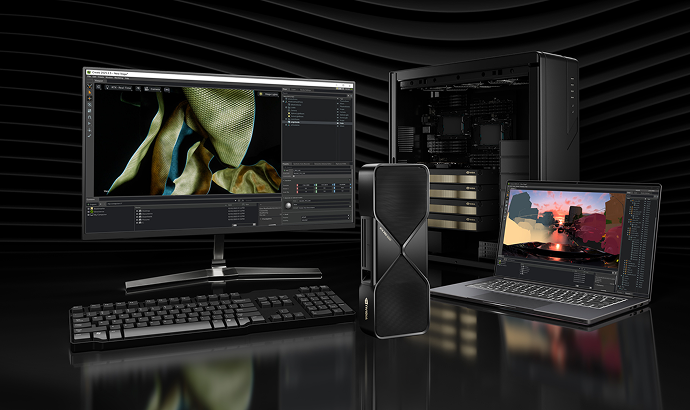

Writing About AI
Uvation
Reen Singh is an engineer and a technologist with a diverse background spanning software, hardware, aerospace, defense, and cybersecurity. As CTO at Uvation, he leverages his extensive experience to lead the company’s technological innovation and development.

The NVIDIA RTX 5090, built on the Blackwell architecture, represents a significant leap forward in enterprise AI, offering a staggering 15x performance boost, a larger 463mm² die area, and double the IP density compared to its predecessors. While NVIDIA’s innovations have long been recognised by gamers, the true revolution lies in its application within enterprise AI, cloud computing, and data analytics. Traditional CPU-based servers, once the bedrock of business operations, struggle to cope with the demands of modern AI-driven workloads. The RTX 5090, with its enhanced tensor cores and AI-driven inference, is specifically designed for parallel processing, accelerating training times, enabling real-time AI processing at an unprecedented scale, and ultimately leading to rapid decision-making, cost efficiencies, and unmatched scalability for businesses. Its next-gen CUDA Cores (170, up from 128 in the RTX 4090) deliver a 33% performance boost, alongside expanded memory bandwidth, DLSS 4 for superior AI-driven image processing, and greater energy efficiency, which translates to reduced operational costs.
DeepSeek’s R1 AI model is setting new benchmarks in AI reasoning, problem-solving, and logical inference, having been officially launched in early 2025. It improves upon its predecessor with reinforcement learning and supervised fine-tuning, ensuring higher accuracy and adaptability. Businesses should take note because R1 offers optimised efficiency, performing complex reasoning tasks with fewer computational resources. Its open-source accessibility also reduces licensing costs and democratises AI capabilities, while its proven performance competes with industry-leading AI models, especially in areas like maths, logic, and real-time problem-solving. When combined with the unparalleled processing power of the NVIDIA RTX 5090, R1’s capabilities expand dramatically, enabling enterprises to process AI-driven insights faster than ever before. This synergy allows for the swift analysis of massive datasets and the implementation of sophisticated AI applications across various industries.
The powerful combination of the NVIDIA RTX 5090 and DeepSeek’s R1 AI model offers transformative use cases for enterprises across multiple sectors. Firstly, it significantly accelerates data analytics, allowing financial institutions, healthcare providers, and e-commerce platforms to process terabytes of data in minutes, enabling instant actionable insights, such as detecting fraudulent transactions in seconds or personalising customer recommendations in real time. Secondly, it strengthens cybersecurity by enabling rapid, AI-driven anomaly detection to prevent attacks before they escalate. Thirdly, it enhances customer experience through ultra-responsive, intuitive, and intelligent AI-powered chatbots and virtual assistants, even predicting and proactively resolving customer issues. Finally, it optimises supply chain operations through AI-powered predictive analytics and real-time data processing, allowing businesses to anticipate demand fluctuations, optimise inventory, and streamline logistics, leading to reduced costs and improved efficiency.
Beyond its raw performance, the NVIDIA RTX 5090 offers several key advantages that redefine enterprise computing. Its next-gen CUDA Cores provide a 33% performance boost, while expanded memory bandwidth effortlessly processes massive datasets and AI workloads. DLSS 4 (Deep Learning Super Sampling) transforms enterprise visualisations with superior AI-driven image processing. Furthermore, a critical advantage is its greater energy efficiency, which means higher performance with reduced power consumption, directly lowering operational costs for businesses. These features are particularly crucial for industries like finance, healthcare, and logistics, where every millisecond and every penny counts, enabling businesses to operate faster, smarter, and more efficiently.
AI has transitioned from an experimental technology to a necessity for modern enterprises due to the overwhelming volume of data businesses generate and process, and the increasing demand for speed and efficiency. AI is now integral to various business functions, from enhancing customer interactions and optimising supply chains to detecting cyber threats, thereby fueling enterprise growth. However, as AI models grow more advanced, outdated infrastructure can create bottlenecks, slow processing, and inflate costs. Technologies like the NVIDIA RTX 5090 address this challenge by providing the unrivalled performance needed to fully harness AI’s potential without compromising speed, efficiency, or scalability, making it an indispensable tool for competitive advantage in today’s data-driven world.
Despite the clear advantages, adopting AI-driven GPUs like the NVIDIA RTX 5090 presents several implementation challenges that require careful planning. Firstly, there’s integration complexity, as legacy systems may need significant upgrading for seamless deployment. Secondly, handling vast amounts of enterprise data necessitates stringent security measures to mitigate data privacy risks. Thirdly, workforce adaptation is crucial, as employees will require training to maximise the benefits of AI-powered workflows and integrate them effectively into their daily tasks. By taking a structured approach, prioritising security from the outset, and investing in employee training, enterprises can navigate these challenges smoothly and unlock AI’s full potential, ensuring a successful transition and long-term competitive advantage.
The future of AI-powered computing promises continued innovation, with several key trends emerging. We can expect more efficient GPUs that enhance speed while further minimising energy consumption, making AI solutions even more sustainable and cost-effective. Edge AI computing is also on the horizon, where AI-powered GPUs will shift more processing to the edge, enabling real-time decision-making in critical industries such as healthcare and autonomous vehicles. Furthermore, deeper integration between NVIDIA and DeepSeek is anticipated, which could lead to the development of even more advanced and sophisticated AI solutions specifically tailored for enterprises. Early adopters of these AI-powered GPUs and integrated solutions are poised to set new industry standards, driving forward the next wave of technological transformation.
The NVIDIA RTX 5090 and DeepSeek’s R1 model deliver significant cost efficiencies and enhanced scalability for businesses in several ways. The RTX 5090’s ability to slash training times and enable real-time AI processing at an unprecedented scale means that businesses can achieve desired outcomes faster, reducing the computational resources and time traditionally required for complex AI tasks. Its greater energy efficiency also translates directly to lower operational costs through reduced power consumption. DeepSeek’s R1 model contributes by offering optimised efficiency, performing complex reasoning tasks with fewer computational resources, and its open-source accessibility helps reduce licensing costs. This combined synergy allows enterprises to handle massive datasets and sophisticated AI workloads more efficiently, scale their AI operations without incurring prohibitive costs, and ultimately make faster, more informed decisions, leading to overall cost savings and a more agile business model.
We are writing frequenly. Don’t miss that.
